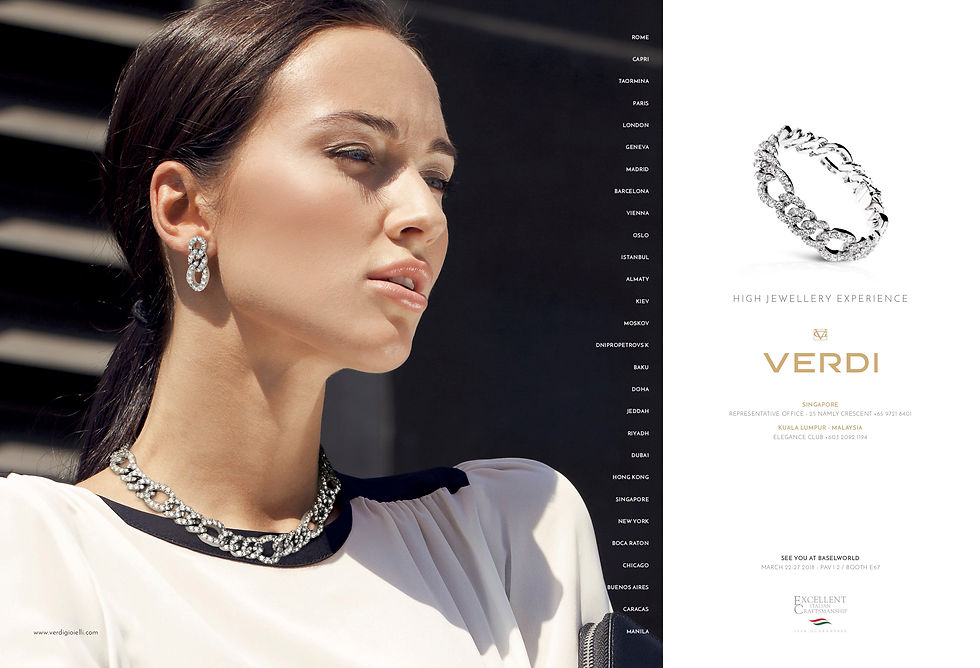History
The company was established by Giuseppe Verdi in 1971; it had been inherited from the experience of his father-in-law, who had founded the Varona e Bistolfi company, active since 1946 and specialised in white gold and precious stones brooches. Many changes took place both at productive and market level: in the seventies the company sold to European wholesalers; since the eighties, production became more varied, the main product being spring bracelets, and participation in trade fairs became of prime importance (in particular, Milan's Gold Italia, the Vicenza, Valenza and Basel fairs); the major markets included the United States and Europe.
In 1991 Marco Verdi took over the company. During these years, production focused exclusively on designs created within the company, as opposed to relying on external designers as in the past. As a result, the exclusivity of the production increased and the parures composed of bracelets and earrings became the brand's flagship product.
Over the years, the spring bracelets continued to be one of the company's excellences, much appreciated in the Middle and Far East, while the North American market lost importance.
Jewellery has traditionally been set with diamonds and other precious stones; however, recent collections have seen a greater use of coral and brightly coloured semi-precious stones, in tune with the tastes and demands of customers. Verdi always paid great attention to detail and to the quality of workmanship.
All production is now carried out within the company, with a working group of 14 people. The Verdi brand, exclusively made in Italy, is therefore appreciated in the Middle Eastern, Russian and Far Eastern markets.
The international jet set also wears the company's creations.
Based on a design by Gino Paoli, Verdi created an exclusive piece of jewellery, the sale of which was donated to multiple sclerosis research.
Giuseppe Verdi was president of the Valenza Goldsmiths' Association (now part of Confindustria Alessandria) for two terms, from 1986 and 1992.
In 2016 Giuseppe Verdi was awarded the S. Eligio prize.
Archive
Most of the preserved documentation dates from around 1970. The drawings are stored in a cupboard and are dated from 1990 onwards; they are first prepared on paper and then transferred to digital format. Rubbers are stored in the factory from the late 1990s onwards; there is a progressive number for each rubber corresponding to the model. Each item has its own data sheet, which is periodically updated; these documents are both paper and digital. Advertising catalogues are present since 2000; each catalogue is renewed every two years, in paper and digital format.
The following series are of particular note:
- Technical catalogues: a few dozen, with reference to moulds
- Drawings: a cabinet
- Rubber moulds: not quantified
- Vile metal models: not quantified
- Photographs: 3 albums (from the 1980s to the end of the 1990s). Today the pictures concern only part of the collection and are in digital form.
- Advertising material (brochures, catalogues), 2000 - 2016
- Fact sheets: paper (since the 1980s); digital (since the 2000s)
Sources
W. Fochesato, R. Massola. Gioielli su carta. Ricchezze dorate fra disegni e cartoline: da Valenza all'Italia, Interlinea, Novara 2018, drawing reproduced on p. 59
L. Lenti, Gioielli e gioiellieri di Valenza. Arte e storia 1825-1975, Allemandi Turin 1994. Descriptive item

G. Verdi & C. s.r.l.
Via XXIX Aprile, 8
15048 Valenza (AL)
+39 0131927254
info@verdigioielli.com
www.verdigioielli.com




































